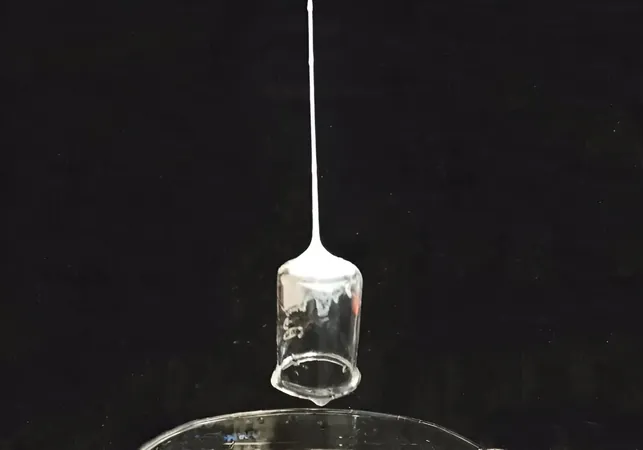
Web-Slinging Technology Inspired by Spider-Man: A Breakthrough at Tufts University!
2024-10-10
Author: Ting
Introduction
Every child who has delved into the world of comic books or tuned into a Spider-Man flick has daydreamed about the exhilarating rush of shooting webs from their wrists and soaring through the city. Researchers at Tufts University have taken these fantastical notions and turned them into reality by developing a pioneering web-slinging technology. Imagine a fluid material that shoots from a small needle, rapidly solidifying into a strong string that can lift objects – it's like something straight out of a superhero movie!
The Science Behind the Technology
Published in the esteemed journal *Advanced Functional Materials*, the study reveals how Tufts University’s Silklab harnessed the natural power of silk moth cocoons. By boiling the cocoons in a solution to break them down into fibroin proteins, scientists created a silk fibroin solution that can be extruded through narrow needles. When mixed with the right additives, this solution solidifies into a durable fiber upon exposure to air.
Inspiration from Nature
The inspiration for this innovation comes from the natural world, where a diverse array of creatures, such as spiders, bees, and moths, produce silk at some point in their lifecycle. Beyond its web-slinging capabilities, silk fibroin has shown promise in various applications, including robust underwater adhesives, printable sensors adaptable to any surface, edible coatings that can prolong produce shelf life, and advanced materials that boost solar energy efficiency.
Overcoming Challenges
Despite these advancements, Tufts University researchers initially struggled to replicate the incredible versatility of spider silk, particularly its varying stiffness, elasticity, and adhesive properties. However, a serendipitous accident led to a groundbreaking revelation. While working on strong adhesives from silk fibroin, Marco Lo Presti, a research assistant professor, observed a web-like material forming while cleaning glassware with acetone. This unplanned discovery opened doors to overcoming long-standing engineering challenges in mimicking spider silk.
The Process of Creation
When silk fibroin solution is exposed to organic solvents such as ethanol or acetone, it gradually transforms into a semi-solid hydrogel. However, by incorporating dopamine—an essential component in their adhesive creation—the researchers expedited the solidification process. This resulted in the rapid formation of fibers with remarkable tensile strength and stickiness, utilizing the same chemistry that barnacles employ for adhesion.
Innovative Fiber Spinning
The next innovative step involved spinning these fibers in the air. By incorporating dopamine, which helps draw water away from the silk, and shooting this solution through a coaxial needle surrounded by acetone, the team successfully created fibers that solidified mid-air. The acetone evaporates, leaving behind a sturdy fiber attached to any surface it touches.
Performance Enhancements
To enhance performance further, they enriched the silk fibroin-dopamine solution with chitosan, a component derived from insect exoskeletons, resulting in fibers boasting up to 200 times greater tensile strength. They also introduced borate buffer into the mixture, boosting the fibers' adhesive properties 18-fold.
Remarkable Capabilities
Remarkably, the device can project fibers capable of lifting objects weighing over 80 times their own weight! In their tests, the researchers demonstrated the technology's effectiveness by lifting a variety of items—including a cocoon, a steel bolt, and even a scalpel buried partially in sand—from a distance of around 12 centimeters.
Quote from Researcher
According to Lo Presti, "If you observe nature, you'll see that spiders don’t actually shoot their webs. They spin silk from their glands, contact surfaces, and draw lines to build their webs. Our work showcases a method to shoot a fiber from a device, adhere to, and lift an object from a distance. It's not just bio-inspired; it's a technology drawn straight from a superhero comic!"
The Path Ahead
While natural spider silk remains around 1,000 times stronger than the engineered fibers created in this study, continued innovation and creative thinking promise to bridge that gap. As Fiorenzo Omenetto, the Frank C. Doble Professor of Engineering at Tufts and director of Silklab, wisely says, “As scientists and engineers, we navigate the boundary between imagination and practice. That's where all the magic happens.”
Conclusion
Stay tuned, as this superhero-inspired technology might just revolutionize numerous industries – from medicine to construction!



 Brasil (PT)
Brasil (PT)
 Canada (EN)
Canada (EN)
 Chile (ES)
Chile (ES)
 España (ES)
España (ES)
 France (FR)
France (FR)
 Hong Kong (EN)
Hong Kong (EN)
 Italia (IT)
Italia (IT)
 日本 (JA)
日本 (JA)
 Magyarország (HU)
Magyarország (HU)
 Norge (NO)
Norge (NO)
 Polska (PL)
Polska (PL)
 Schweiz (DE)
Schweiz (DE)
 Singapore (EN)
Singapore (EN)
 Sverige (SV)
Sverige (SV)
 Suomi (FI)
Suomi (FI)
 Türkiye (TR)
Türkiye (TR)